Comments / Questions (50)
![]() Begoña Martorell wrote:
Begoña Martorell wrote:
Buenas tardes, he acabado todo el círculo completo, y no sé cómo continuar para hacer los delanteros, gracias. Un saludo desde España!
01.09.2024 - 15:45DROPS Design answered:
Hola Begoña, desde el centro del lado del escote (en la parte superior del círculo) cuentas el punto central + 19 puntos a cada lado. Estos son puntos para el cuello y no se trabajarán en los delanteros. Cuenta los siguientes 87 puntos desde cada lado; estos serán los puntos para cada delantero y tienen que incluir las sisas. Finalmente, te quedan 39 puntos en la parte inferior del círculo, para la parte inferior de la espalda. Insertas los marcapuntos como se indica y se trabaja de ida y vuelta con 1 p.a.d en cada punto y aumentando antes o después de los marcapuntos, alternadamente y disminuyendo 3 pts al final de cada fila, en ambos extremos del delantero.
08.09.2024 - 20:02
![]() Kati wrote:
Kati wrote:
Hallo, werden die Fäden nach jedem Streifen abgeschnitten und vernäht oder mitgeführt? LG
27.05.2024 - 12:53DROPS Design answered:
Liebe Kati, Sie können die Fäden mitführen wenn die Streifen nicht zu hoch sind, beachten Sie nur, daß sie nicht zu eng sind. Viel Spaß beim Häkeln!
27.05.2024 - 13:05
![]() Pia Sesterhenn wrote:
Pia Sesterhenn wrote:
Hallo liebes Drops Team, mmit den Vorderteilen komme ich leider gar nicht klar: die Zunahmen und Abnahmen werden gleichzeitig gemacht ??? Über eine Hilfestellung freue ich mich sehr, da ich die Jacke sehr originell finde. Herzlichen Dank.Viele Grüße Pia Sesterhenn
04.03.2019 - 21:38DROPS Design answered:
Liebe Frau Sesterhenn, ja genau, es wird am Anfang und am Ende jeder Reihe abgenommen - siehe ABNAHMETIPP 1- und gleichzeitg an jede Markierung zugenommen. Viel Spaß beim häkeln!
05.03.2019 - 12:02
![]() Engnath wrote:
Engnath wrote:
Ist die Maschenprobe zweifädig analog dem Garnvorschlag zu erstellen? Ich möchte die Jacke mit einem einfädig mit einem Farbverkaufsgarn probieren.
03.06.2018 - 11:18DROPS Design answered:
Liebe Frau Engnath, wenn Sie 2 Fäden Garngruppe A durch 1 Faden Garngruppe C ersetzen, dann sollen Sie die gleiche Maschenprobe haben - hier lesen Sie mehr über Garnalternativen. Viel Spaß beim häkeln!
04.06.2018 - 09:18Jess wrote:
Can you please clarify how many pieces are needed for the sleeves? If I crochet 1 piece for each sleeve and join that piece together with one side seam, that sleeve is too small to fit into the armhole. So should I be crocheting two sleeve pieces together to make one sleeve,(so 4 sleeve pieces in total?) The armhole is way too big to crochet if only one sleeve piece done.
20.06.2016 - 10:13DROPS Design answered:
Dear Jess, you have to crochet 2 sleeves - sleeve are worked back and forth, from cap of sleeves down to armhole then to wrist edge, then sewn tog around. You first inc for sleeve cap, then dec along "arm" it self. Happy crocheting!
20.06.2016 - 12:03
![]() Karin wrote:
Karin wrote:
Hallo, Ik heb het vest nu bijna af. Echter het lijf is wel heel anders uitgevallen alsop de foto, bij mijvalt het achter in twee wijde plooien over mijn rug. Ik heb de kleinste maat genomen, en toch valt het veel te wijd. Verandert dit zodra ik de mouwen aan zai misschien? Ook lijkt het alsof ik met het garen vooral de lichtpaarse kleur waar ik een rand van wil maken niet uitkom. Heel erg mooi patroon verder, maar zou jammer zijn als het niet goed zou vallen.
12.02.2016 - 13:45DROPS Design answered:
Hoi Karin. Het is helaas moeilijk voor mij om in te schatten op afstand. Maar kloppen de afmetingen wel zoals op de maattekening en de stekenverhouding?
10.03.2016 - 14:20
![]() Maritza wrote:
Maritza wrote:
Hello,i love your patterns,i am crocheting calypso drops 140-22,but I am confused how to start the left side,the large pattern said to count 27 sts from the side ,I marked the 41 sts top and bottom,but I do not understand from witch point I start to count the 27sts,thanks a lot
11.11.2015 - 01:48DROPS Design answered:
Dear Maritza, the left front piece is worked over 87 sts - insert 2 markers as follows: 27 sts, insert 1 marker, 33 sts, insert 1 marker, 27 sts = 87 sts. Happy crocheting!
11.11.2015 - 09:28
![]() Annie wrote:
Annie wrote:
Hallo Ook ik ben met dit vest bezig en ik moet nu de mouw innaaien maar de mouwkop in het vest is veeeel breder dan de mouwkop van de mouw . Dit past echt niet . De mouwkop van get vest is 36 cm ongeveer en due van de mouw 18
05.08.2015 - 08:08DROPS Design answered:
Hoi Annie. Nu weet ik niet welke maat je maakt, maar een mouwkop zal nooit precies dezelfde afmetingen hebben als het armsgat ivm de schuine randen. Het is wel - zoals altijd - heel belangrijk dat de stekenverhouding correct is, of dan kan de afmetingen verkeerd uitkomen.
05.08.2015 - 14:14
![]() Sylvia wrote:
Sylvia wrote:
Sorry hoor die woordspeling ook mouwloos is mouwkop
03.08.2015 - 16:15
![]() Sylvia wrote:
Sylvia wrote:
Hallo Mouwloos is mouwloos hoor in mijn vorige vraag
03.08.2015 - 16:13
Calypso#calypsojacket |
|
 |
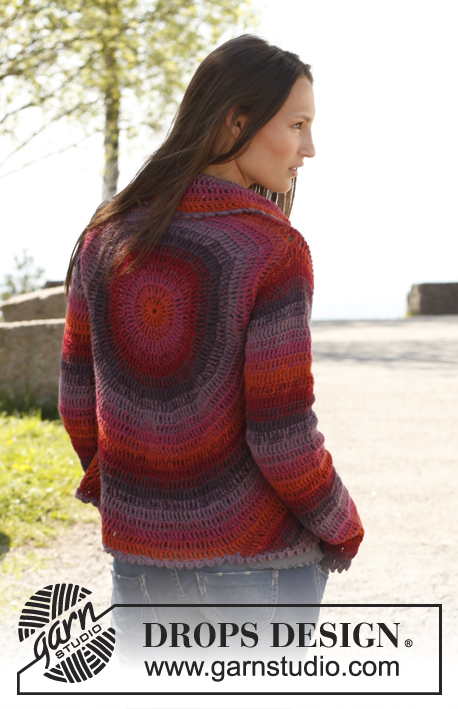 |
Crochet DROPS jacket worked in a circle in 2 strands "Alpaca". Size: S - XXXL.
DROPS 140-22 |
|
|
STRIPES: Work 1 round with every color combination as follows: 2 strands 2925 1 strand 3770 + 1 strand 2925 2 strands 3770 1 strand 3770 + 1 strand 3900 2 strands 3900 1 strand 3900 + 1 strand 6736 2 strands 6736 1 strand 6736 + 1 strand 3800 2 strands 3800 1 strand 3800 + 1 strand 3770 Then work 1 round with every color combination and repeat upwards as follows: 2 strands 3770 1 strand 3770 + 1 strand 2925 2 strands 2925 1 strand 2925 + 1 strand 3900 2 strands 3900 1 strand 3900 + 1 strand 6736 2 strands 6736 1 strand 6736 + 1 strand 3800 2 strands 3800 1 strand 3800 + 1 strand 3770 CROCHET TIP: Replace first tr on every round/row with ch 4. DECREASE TIP 1 (applies to body): Dec as follows: Work tr until 3 tr remain, * in the first of these work 1 dc, in the next 1 hdc and in the last 1 sc, turn with ch 1, skip sc, work 1 sl st in hdc and 1 sl st in dc, then 1 sc in first tr, 1 hdc in next tr and 1 dc in next tr, work tr until 3 tr remain at end of row *, repeat from *-* until a total of 6-8-12 rows have been worked. DECREASE TIP 2 (applies to sleeve): Dec at beg of row by working sl sts over the no of tr to be dec. Dec at end of row by working until same no of tr to be dec remains, turn piece. -------------------------------------------------------- BODY: Read US/UK above! Worked in the round in a circle from mid back with 2 strands Alpaca and STRIPES – see explanation above. Ch 8 on hook size 5 mm / H/8 and form a ring with 1 sl st in first ch. ROUND 1: Work 16 tr in ch-ring. READ CROCHET TIP! ROUND 2: 2 tr in every tr = 32 tr. ROUND 3: * 1 tr in next tr, 2 tr in next tr *, repeat from *-* the entire round = 48 tr. ROUND 4: * 1 tr in each of next 2 tr, 2 tr in next tr *, repeat from *-* the entire round = 64 tr. ROUND 5: * 1 tr in each of next 3 tr, 2 tr in next tr *, repeat from *-* the entire round = 80 tr. ROUND 6: * 1 tr in each of next 4 tr, 2 tr in next tr *, repeat from *-* the entire round = 96 tr. ROUND 7: * 1 tr in each of next 5 tr, 2 tr in next tr *, repeat from *-* the entire round = 112 tr. ROUND 8: * 1 tr in each of next 6 tr, 2 tr in next tr *, repeat from *-* the entire round = 128 tr. ROUND 9: * 1 tr in each of next 7 tr, 2 tr in next tr *, repeat from *-* the entire round = 144 tr. ROUND 10: * 1 tr in each of next 8 tr, 2 tr in next tr *, repeat from *-* the entire round = 160 tr. ROUND 11: * 1 tr in each of next 9 tr, 2 tr in next tr *, repeat from *-* the entire round = 176 tr. ROUND 12: Work 1 tr in every tr but work 2 tr in every 16th tr = 187 tr. Piece now measures approx. 20 cm / 8" from the middle and out. SIZE S/M: ROUND 13: ch 1, then work 1 sc in each of the first 45 tr (= up towards neck), ch 30 loosely, skip the next 27 tr (= armhole), then work 1 sc in each of the next 88 tr (= down towards back), ch 30 loosely, skip the next 27 tr (= armhole) and fasten with 1 sl st in first sc on round. ROUND 14: Work 1 tr in every sc - but inc 2 tr evenly over the first 45 sc (= 47 tr), then work 30 tr in ch-row over armhole, work 1 tr in every sc – but inc 3 tr evenly over the bottom 88 sc (= 91 tr), work 30 tr in ch-row over armhole and fasten with 1 sl st in 4th ch = 198 tr. ROUND 15 to 23: Continue with tr – while at the same time inc 6 tr evenly on every round. After 23rd round there are 252 tr on the round and piece now measures approx. 42 cm / 16½" from the middle and out. Continue working only over 87 tr in each side – i.e. do not work over 39 tr at top by neck and 39 tr at bottom of back. Cut the thread. Continue with explanation under left front piece. SIZE L/XL: ROUND 13: Work 1 tr in every tr but work 2 tr in every 17th tr = 198 tr. ROUND 14: 1 ch, then work 1 sc in each of the first 50 tr (= up towards neck), ch 32 loosely, skip the next 29 tr (= armhole), then work 1 sc in each of the next 90 tr (= down towards back), ch 32 loosely, skip the next 29 tr (= armhole) and fasten with 1 sl st in first sc on round. ROUND 15: Work 1 tr in every sc - but inc 3 tr evenly over the first 50 sc (= 53 tr), then work 32 tr in ch-row over armhole, work 1 tr in every sc – but inc 3 tr evenly over the bottom 90 sc (= 93 tr), work 32 tr in ch-row over armhole and fasten with 1 sl st in 4th ch = 210 tr. ROUND 16 to 24: Continue with tr – while at the same time inc 6 tr evenly on every round. After 24th round there are 264 tr on the round and piece now measures approx. 44 cm / 17¼" from the middle and out. Continue working only over 91 tr in each side – i.e. do not work over 41 tr at top by neck and 41 tr at bottom of back. Cut the thread. Continue with explanation under left front piece. SIZE XXL/XXXL: ROUND 13: Work 1 tr in every tr but work 2 tr in every 17th tr = 198 tr. ROUND 14: Work 1 tr in every tr but work 2 tr in every 18th tr = 209 tr. ROUND 15: 1 ch, then work 1 sc in each of the first 54 tr (= up towards neck), ch 36 loosely, skip the next 32 tr (= armhole), then work 1 sc in each of the next 91 tr (= down towards back), ch 36 loosely, skip the next 32 tr (= armhole) and fasten with 1 sl st in first sc on round. ROUND 16: Work 1 tr in every sc - but inc 2 tr evenly over the first 54 sc (= 56 tr), then work 36 tr in ch-row over armhole, work 1 tr in every sc – but inc 3 tr evenly over the bottom 91 sc (= 94 tr), and work 36 tr in ch-row over armhole = 222 tr. ROUND 17 to 26: Continue with tr – while at the same time inc 6 tr evenly on every round. After 26th round there are 282 tr on the round and piece now measures approx. 47 cm / 18½" from the middle and out. Continue working only over 95 tr in each side – i.e. do not work over 46 tr at top by neck and 46 tr at bottom of back. Continue with explanation under left front piece. LEFT FRONT PIECE - ALL SIZES: = 87-91-95 tr. Insert a marker after 27-29-33 sts in from each side (= 33-33-29 sts between markers). Then work tr back and forth over these sts while at the same time inc 1 st at every marker on every row (i.e. inc 2 sts on row, inc alternately before and after every marker) and dec 3 sts at beg and end of every row in each side - SEE DECREASE TIP 1 - until a total of 6-8-12 rows have been worked back and forth = 63-59-47 tr. RIGHT FRONT PIECE: Work the same way as on left front piece over the 87-91-95 tr in the right side. SLEEVE: Worked back and forth from sleeve cap and down with 2 strands Alpaca and STRIPES – see explanation above. Begin in the same color as round 13-14-15 on body, continue with stripes as on body. Ch 28-34-38. Turn and work 1 tr in 5th ch from hook ( = 2 tr), then work 1 tr in every ch = 25-31-35 tr. ROW 2: Ch 4, 3 tr in first tr, 1 tr in each of the next 23-29-33 tr, 4 tr in the last tr = 31-37-41 tr. Turn. ROW 3, 4 and 5: Ch 4, 2 tr in first tr, 1 tr in every tr until 1 tr remains, 3 tr in the last tr = 43-49-53 tr. Turn. ROW 6: Ch 4, 3 tr in first tr, 1 tr in each of the next 41-47-51 tr, 4 tr in the last tr = 49-55-59 tr. Turn. Then work 1 tr in every tr, AT THE SAME TIME when piece measures 14 cm / 5½", dec 1 tr in each side – SEE DECREASE TIP! Repeat dec every 7-5-5 cm / 2¾"-2"-2" 5-7-7 more times = 37-39-43 tr. Continue with 1 tr in every tr until sleeve measures approx. 61-61-61 cm / 24"-24"-24" (same in all sizes because of wider shoulders on body). Fasten off. ASSEMBLY: Sew sleeve seams tog edge to edge to avoid a chunky seam. Work 1 picot edge around the entire body and at the bottom around the sleeves with 2 strands in the last color used as follows: 1 sl st, * ch 5, 1 dc in first ch, skip 1 st, fasten with 1 sc in next st *, repeat from *-* the entire round and finish with 1 sl st in first ch. Sew in the sleeves. |
|
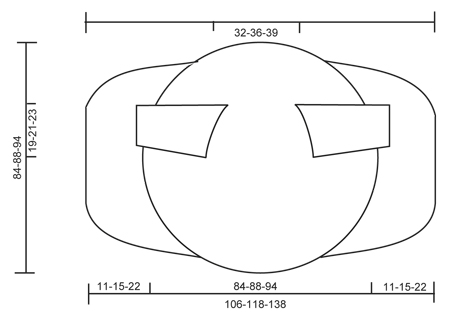
|
|
Have you finished this pattern?Tag your pictures with #dropspattern #calypsojacket or submit them to the #dropsfan gallery. Do you need help with this pattern?You'll find 8 tutorial videos, a Comments/Questions area and more by visiting the pattern on garnstudio.com. © 1982-2025 DROPS Design A/S. We reserve all rights. This document, including all its sub-sections, has copyrights. Read more about what you can do with our patterns at the bottom of each pattern on our site. |
|







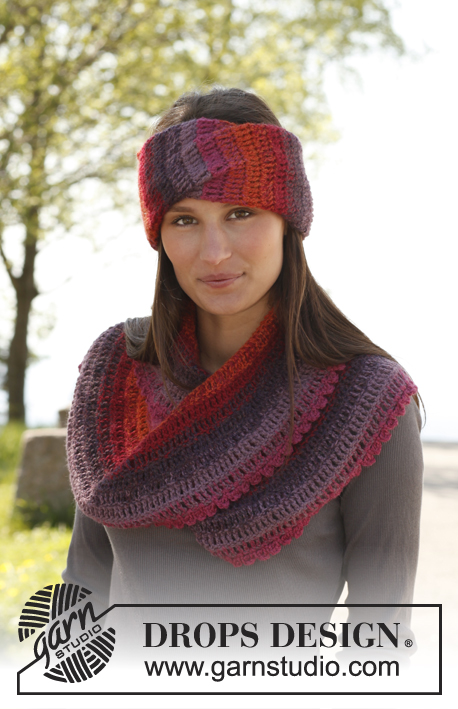
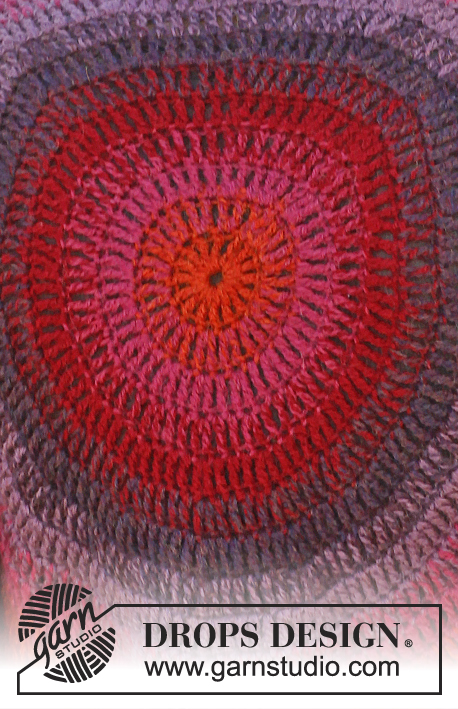

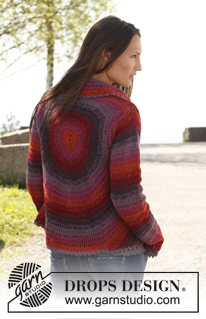

































Post a comment to pattern DROPS 140-22
We would love to hear what you have to say about this pattern!
If you want to leave a question, please make sure you select the correct category in the form below, to speed up the answering process. Required fields are marked *.